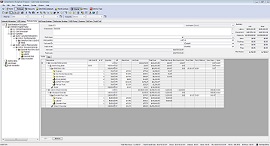
|
www.agc.org Contact Us Archives/Subscribe Advertise IT Forum IT Forum Steering Committee |
Get Your Team on the Same Page with Work Breakdown StructuresBY PAUL MCKEON, CEO
B2W SOFTWARE
Estimating large construction projects with accuracy, efficiency and confidence is a difficult challenge. One of the best strategies for addressing the complexities is to break down the project into smaller, more manageable pieces of work through what is commonly referred to as Work Breakdown Structures (WBS).
Estimating tools with robust and flexible support for WBS provide a critical advantage and can ensure that all team members are on the same page. They allow estimators to dissect and categorize all work elements to produce accurate costs more efficiently. They also enable estimators to instantly adjust costs, realign the project and share information with all team members.
It is important to note that all WBS capabilities are not created equal. Some estimating software programs say they provide WBS functionality. However, they often come with hidden elements of inflexibility, difficult processes and lack of scalability that can inhibit utilization and effectiveness. True WBS software provides a digital template for breaking down complex requirements into smaller, more manageable pieces for project estimation, planning and execution while also:
● Clearly identifying the requirements and deliverables of the project
● Putting structure around the scope of the project
● Subdividing the scope into size, duration and responsibilities
● Categorizing activities into hierarchical levels
● Providing a detailed listing of all project requirements
● Defining all resources required
● Giving a meaningful, pictorial view of the project for stakeholders.
This process represents a repeatable and predictable way of estimating, which increases efficiency and accuracy while also helping companies adhere to budgets and timeframes.
 When using WBS capabilities, an estimator starts with the overall project and breaks it out into divisions representing the specific scopes of work required by the project. The estimator starts with the broadest scope for the initial breakdown levels and then refines each into more specific sub-levels, sub-sub-levels, and so on. This helps to organize the estimate into something that is easy to understand and at a high level of granularity. When using WBS capabilities, an estimator starts with the overall project and breaks it out into divisions representing the specific scopes of work required by the project. The estimator starts with the broadest scope for the initial breakdown levels and then refines each into more specific sub-levels, sub-sub-levels, and so on. This helps to organize the estimate into something that is easy to understand and at a high level of granularity.For example a company could create an estimate for a bridge construction project, which could be broken down into multiple divisions including "demolition," "earthwork," "site construction," "concrete" and "asphalt paving." Under a division — "concrete" for example — associated tasks such as "concrete reinforcing" and "cast-in-place concrete" could be broken out as subdivisions. These subdivisions could then be broken down further, if necessary, to arrive at terminal level where a cost can be assigned.
The WBS represents 100 percent of the work needed to complete the project. Therefore the estimating software must be able to detail each division out into as many subdivisions, sub-subdivisions, and so on as needed for the scopes of work to be specific enough for meaningful estimates to be made.
Collaborative estimating software can also make WBS a team activity, allowing applicable team members to view and discuss each high-level requirement to clearly determine or adjust the activity details in real time. Activity details are combined with the requirements of other team members for consolidating and collating the next steps of project planning and scheduling.
WBS is not a project plan or a project schedule. Instead, it details the initial scope and final deliverables to help give accurate input for creating a project schedule derived from activity and work information.
Using an estimating tool with strong WBS capabilities can also provide a competitive advantage for companies by:
1. Keeping information organized in a way that makes the most sense to estimators and the business
2. Promoting project efficiency
3. Helping to ensure that there are no hidden or repeat costs
4. Clearly outlining the responsibilities of all team members, so no tasks are missed
5. Helping estimators cater the WBS to the specific company requirements
6. Creating an agile process by modifying levels as the project continues to be refined
7. Providing visibility via in-depth reporting, so costs are kept organized by project category
Ease of use is also a critical component of effective WBS tools. This is necessary for companies to create and manipulate estimates efficiently, in order to get a bid out the door. If an estimating software application is too rigid, estimators will not have the ability to quickly calculate project costs. Reusable structures and procedures save time and money while also allowing estimators to concentrate on the actual information rather than its layout.
In conclusion, using estimating software with the right WBS capabilities helps with assignment of responsibilities, allocation of resources, and the monitoring and controlling of the project. Automating this process makes the deliverables more precise, so that each team member knows what his or her responsibilities are and exactly how to accomplish them. With the entire team literally on the same page, companies can easily double check all the deliverables to ensure that there is nothing missing or overlapping. Paul McKeon is chief executive officer at B2W Software, a leading provider of enterprise-class construction software, services and solutions. Kevin brings more than 20 years of leadership to his role, with experience building collaborative organizations with strong customer focus, while driving profitability for both venture capital-backed startups and publicly traded S&P 500 corporations. For more information, visit www.b2wsoftware.com. |

2300 Wilson Boulevard, Suite 300 · Arlington, VA 22201 · 703-548-3118 (phone) · 703-548-3119 (fax) · www.agc.org
About AGC | Advocacy | Industry Topics | Programs and Events | Career Development | News & Media
© Copyright 2025 The Associated General Contractors of America. All rights reserved.

